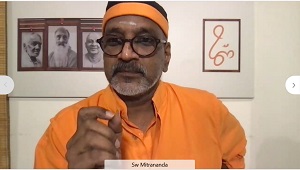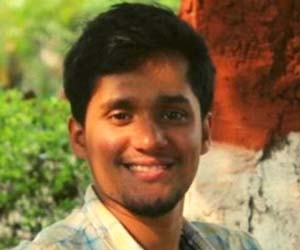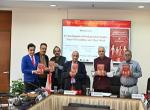On 6th January 2022, Vivekananda International Foundation (VIF) hosted ‘Gītā for the Millennia’; an online talk series based on Śrīmad Bhagavad Gītā by Swami Mitrananda, Chinmaya Mission. In his introductory remarks during the event, Dr. Arvind Gupta, Director – VIF informed that this monthly lecture series comprising 18 sessions, one on each chapter of Śrīmad Bhagavad Gītā aims at seeking guidance from the scripture to continuously inspire us for enlightenment and to foster original thinking among us to rebuild a narrative for India and the world in the contemporary global scenario. Each one and half hour session of this talk series would also carry a Q & A session where participants can personally interact with the speaker.
Swami Mitrananda is a disciple of H.H. Swami Chinmayananda Saraswati and a monk from the Chinmaya Mission order. He currently serves as the mentor for Chinmaya Mission Chennai and North-Eastern India. He is famous for his regular engagement with the youth to inspire them and kindle their interest in Vedānta through dynamic methods such as bike and car rallies, theatre, outdoor experiential learning, etc. Through Chinmaya Mission’s unique Youth Empowerment Program (YEP), he has mentored more than 600 youths to serve Bharat. He also serves as the Director – National Projects of All India Chinmaya Yuva Kendra (AICHYK), the youth wing of Chinmaya Mission, and publisher of ‘Chinmaya Udghosh’, an international youth magazine.
Swami Mitrananda began the lecture by invoking H.H Swami Chinmayanda’s lifetime effort to bring back the Gītā as a ‘book of action’ at a time when its engagement was reduced only to prayer rooms. By highlighting the importance and eternal relevance of the Gītā as it makes the timeless, profound knowledge of Vedas and Upaniṣads comprehensive to the common folk, the speaker then discussed the major themes and emphasized the core of Arjuna Viṣāda-yoga, the first chapter of the Gītā.
The lecture highlighted the fact that the Gītā is a discussion between two warriors on a battlefield, which means that the message of the Gītā is applicable even during utmost tense and uncertain situations. In life, we all have to choose our own ‘battlefields’ or fields of action. In each of them, we have to know and perform our Dharma otherwise one would collapse in between. Hence, understanding our Dharma is very important for which we can resort to the Gītā. But while approaching the Gītā for knowledge, one should always have a mind of humility and reverence and not of arrogance and vanity. A person who thinks s/he knows things better already would fail to understand the Gītā. Indian culture has always encouraged the method of questioning as a means to gain knowledge, but only with a precondition that it should be with a seeking attitude and not with vanity. This message was conveyed in the lecture through a subtle example from the Gītā where Duryodhana approached his teacher, Droṇa, flaunting as a king (....rājā vacanamabravīt, V.2, Ch. 1). Here, the mention of Duryodhana ‘as a king’ who approached his teacher Droṇa subtly conveys the nature or attitude of arrogance in him.
On the other hand, Arjuna emotionally collapsed as he saw his relatives and teachers on the opposite side of the battlefield. Certainly, Arjuna had reverence for his elders due to which he realised the sin of taking arms against them, which had put him in a dilemmatic situation. But it wasn’t as though Arjuna didn’t know he was supposed to fight against them before entering the battlefield. In fact, it was Arjuna himself who asked his charioteer Kṛṣṇa with confidence to bring the chariot right in the middle of the battlefield to have a closer look at his enemies. As Arjuna commanded, Kṛṣṇa took him right to the middle of the battlefield, placing the chariot in front of Bhīṣma and Droṇa, and asked Pārtha to ‘watch’ (.....paśyaitān samaventānkurūniti, V. 25, Ch.1). By bringing this instance and quoting the verse, the lecture highlighted another subtlety embedded in the word ‘paśya’ (watch) uttered by Lord Kṛṣṇa. What Kṛṣṇa wanted Arjuna to watch was to have a closer look at the people who are unfortunately prepared to fight from the side of adharma. It was ‘adharma’ that Kṛṣṇa wanted Arjuna to see. But on the contrary, from an emotional outburst, Arjuna watched ‘his people’ who are his teachers and relatives lined up on the opposite side, against whom he is supposed to fight. After that sight, a brave, confident warrior like Arjuna, emotionally baffled, lost the ability to realise his Dharma, deluded that he fails to identify what is good or bad. Hence, he tells Kṛṣṇa that he can’t and doesn't want to fight the war. Out of despondency and confusion (śoka and moha), Arjuna throws various moral excuses against Kṛṣṇa to justify his decision of not fighting against ‘his people'.
The lecture also reminded us that Indian culture tries its best to avoid war as we are aware of the price we have to pay for it in the future. Kṛṣṇa, who motivated Arjuna to fight the war in the Gītā, himself tried to negotiate and talk for peace prior to it. But when adharma rises, even waging a war against it becomes our duty for the sake of Dharma. The lecture brought a symbolic illustration of this message, when Bhīṣma first blew the conch from the Kaurava side as a call for the war; it was the charioteer Kṛṣṇa who blew the conch from the Pāṇdava side in response. In fact, it was Dṛṣtadhyumna, who was the commander in chief of the Pāṇdava army, who was supposed to respond. It took no time for Kṛṣṇa to decide to respond, as he is ‘acyuta’ (one who never falls), who doesn’t have any doubt about discriminating between what is right and wrong, what is dharma and adharma. Therefore, he is ever ready for a timely response. In life, we face many situations wherein we forget our discriminative power, and fall from our convictions and values. Therefore, all of us must become ‘acyuta’ so that we dont lose the discriminating power even during tough times, when we have to respond. The lecture brought in the profound words of H.H. Swami Chinmayananda, that humorously conveys this message, which goes, “Before a problem, we are wise, after a problem we are wise, during the problem we are otherwise.”
The event concluded after a 30 minutes long question and answer session.
The Gītā shows the art of exercising wisdom even while facing a problem and here the battlefield becomes the best possible example. Each person should revel in the knowledge of the Gītā for gaining clarity and to recognise what is adharma and practice what is dharma, so that we can equip ourselves to give timely and rightful responses to every tough situation in life, whether professional or personal. As a concluding remark to the session, Dr. Arvind Gupta mentioned that the conflicts and confusions are eternal, which continuously takes up new contexts across all ages against which the knowledge of Śrīmad Bhagavad Gītā stands firm and time tested. The upcoming lectures of this series would briefly extract profound messages residing in each chapter of the Gītā .







Post new comment